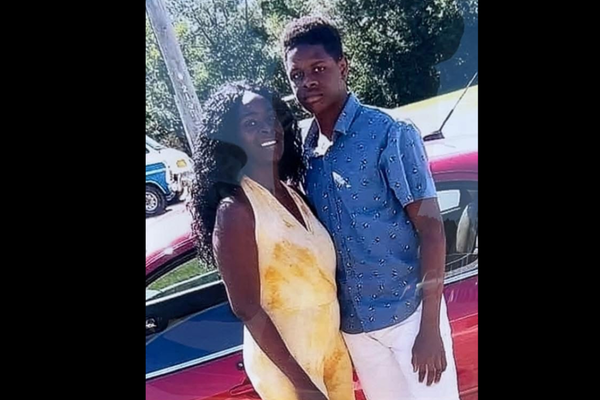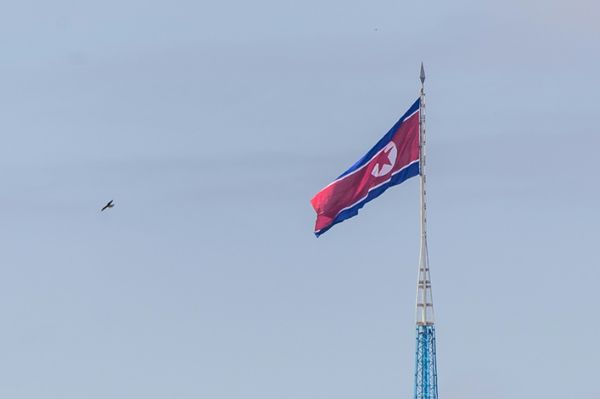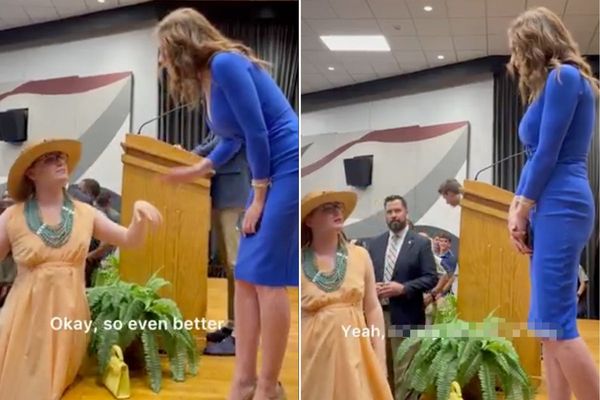The New Ensemble
Mariachi music is on the rise in Texas high schools. The state festival in Edinburg draws the best of the best.

By Robyn Ross
June 10, 2020
For a moment after the Edcouch-Elsa High School mariachi ensemble plays the final notes of “La Petenera,” no one moves. The music seems to linger in the air of the brightly painted cinder block practice room. Then the seven violin players, who’ve all raised their bows with a flourish, slowly lower them to their sides. Everyone takes a breath and looks expectantly toward their head director, Marcos Garcia, who’s checking his watch.
“Nine fifty-seven,” Garcia announces, looking up. Too close. The University Interscholastic League (UIL) State Mariachi Festival, where the ensemble will perform tomorrow, has a strict 10-minute time limit. Edcouch-Elsa’s Mariachi Juvenil Azteca is one of the best in the state. The group can’t risk disqualification for going over the time limit, which would dash the students’ hopes of attaining a coveted Division 1 rating for the fifth year in a row.
Garcia claps his hands. “Let’s pick it up and make faster transitions between songs. You’ve got to give it more energy. Remember: musicality. Expression. Interpretation. Feeling. Let’s get it down to 9:45.”
The 17 students who will perform in the festival take their places. They’re the most dedicated and musically accomplished among the 24 members of the varsity class, for which hopefuls—even upperclassmen who’ve been in the group before—must audition. Senior Nathania Flores, the violin section leader, turns to face her colleagues, making eye contact with each one. She takes a quick, audible breath and then, tapping her foot, slices the bow of her violin through the air: 1, 2. On the next beat, the group begins to play.
The festival kicks off later this morning at the University of Texas Rio Grande Valley (UTRGV) in Edinburg, about 20 minutes away. Over the next two days, 82 high school mariachi ensembles will don their trajes de charro and play their best material before a panel of judges from the academic and professional worlds. It’s only the festival’s second year as a fully sanctioned event organized by the UIL, the statewide organization that governs public school sports as well as academic, music, and theater contests. The UIL’s decision to make the event official was a reflection—and an endorsement—of mariachi’s growing popularity and influence in Texas high schools.
“Mariachi is really starting to come into its own and become more mainstream,” says judge Lauryn Salazar, an ethnomusicologist who directs Texas Tech University’s mariachi groups and plays with the Grammy Award-winning Mariachi Divas. “There’s a lot more interest in these events and creating avenues to showcase Latino culture in a positive light. Essentially what it’s done is put mariachi on the same level as band, orchestra, and choir, and that’s huge.”

Mariachi originated in Jalisco and the surrounding states of western central Mexico. Around 1910, a few groups brought the rural folk music to Mexico City, where it caught on. Over time, the groups swelled from small ensembles, comprising two to six members, to the more than a dozen instruments in today’s concert mariachi groups: six or more violins; two or three trumpets; a harp; one or two regular guitars; the vihuela, a soprano guitar; and a guitarron, the bass instrument that sets the tempo. The orchestral, cinematic quality of the violins is punctuated by festive trumpets and layered over the strumming of the rhythm section, or armonía. Vocalists infuse their words with hyperbolic emotion, evoking longing, bravado, or loss regardless of the listener’s Spanish fluency.
Most Texans are familiar with the small mariachi groups that play al talon (“at the heel”), roaming table to table at restaurants and playing for tips. The currency of such groups—and those who play at weddings and quinceañeras—is a catalog of frequently requested, familiar songs like “Cielito Lindo.” Concert mariachi is a world away, with more instruments, complex arrangements, and a much greater degree of musical difficulty and showmanship.
Edcouch-Elsa’s repertoire includes traditional Mexican folk songs and mariachi hits, like the songs of midcentury stars Pedro Infante and Jorge Negrete, as well as more experimental numbers. For a back-to-school teacher appreciation event, Juvenil Azteca performed an arrangement of the 1987 Guns N’ Roses hit “Sweet Child O’ Mine,” with the opening electric guitar riff played as a harp duet.
While Guns N’ Roses could technically make it into a state festival set, the UIL requires groups to perform one son jalisciense, the indigenous song form of the tradition. The style, whose name is a nod to its origins in Jalisco, is known for its challenging alternation between 3/4 and 6/8 time signatures. The son jalisciense in Edcouch-Elsa’s set, “Toro Coquito,” is preceded by a tema, a one-minute theme song recognized as the group’s signature. A growing number of high school groups have adopted temas, borrowing the practice from professional show groups like Mariachi Vargas de Tecalitlán.
Edcouch-Elsa’s tema, which the violinists sing while the rest of the group plays, proclaims: “Juvenil, ya llegamos a cantar (we’re here to sing); Juvenil, melodías sin igual (our melodies are unmatched); Juvenil, música para alegrar (music to make you happy); su mariachi, Juvenil Azteca (your mariachi, Juvenil Azteca)!”
Some high school mariachis are bilingual; others never spoke Spanish until they started singing it. Although all the students interviewed for this story were born in the United States, many of their grandparents grew up in Mexico, listening to radio versions of the songs their grandchildren now perform. The older generation’s nostalgia seems to seep into the young musicians, who grasp the music’s cultural significance even when they didn’t grow up listening to it.
Garcia and his co-directors always translate and explain the songs for their students, although the context can elude the younger musicians. It’s hard for teenage singers to fully relate to songs about lost love or pride in Jalisco when many have never had a romantic relationship or visited Mexico.
“They’re just young kids,” Garcia says. “So it’s a little more difficult to connect to the lyrics, because a lot of the lyrics of traditional mariachi music talk about either heritage of Mexico or [are] a love ballad that’s heartbreaking, or a drinking song that’s talking about the heartbreak.”
Still, freshman violinist Angelina Rodriguez says mariachi music is more dramatic and intense than the American pop she listens to. Those Top-40 songs are “always about someone not liking you back—like Taylor Swift, ‘Teardrops on my Guitar.’” The stakes are higher in the mariachi tradition, she says. Take Chavela Vargas, a Mexican singer who in the 1950s and ’60s performed traditional rancheras—all written to women—without changing the gender pronouns. Her cover of “Paloma Negra” drips with despair as she laments her romantic interest staying out all night with someone else.
“She was a lesbian woman in this era of Mexico where homosexuals were so oppressed, and she sings ‘Paloma Negra’ about this lady that she’s in love with,” Rodriguez explains. “It’s so much more agony than ‘Oh, my boyfriend broke up with me,’ like Taylor Swift. It’s different. It will make you cry. Of course Taylor Swift can make you cry, too, but this is a different kind. It’s like—”
Freshman violinist H. Matthew Cavazos jumps in. “It’s from the heart.”
“Ojos Tapatios,” a Negrete song that’s part of Edcouch-Elsa’s show, is a flowery ode to a romantic interest’s eyes. “It’s a whole novela in a song,” says trumpet player Daniel Estrada, who transferred to Edcouch-Elsa from a nearby district specifically to play with the top-caliber mariachi ensemble.
Has he, a senior in high school, fallen in love?
“I’ve had it where I see somebody’s eyes and I’m just like—” he rests his chin on his hand and sighs wistfully. He channels those feelings into making his trumpet sing. “If everything’s at the right tempo, you’re going to feel chills all over your body. That’s why I love mariachi music: Because it makes you feel everything in one song.”
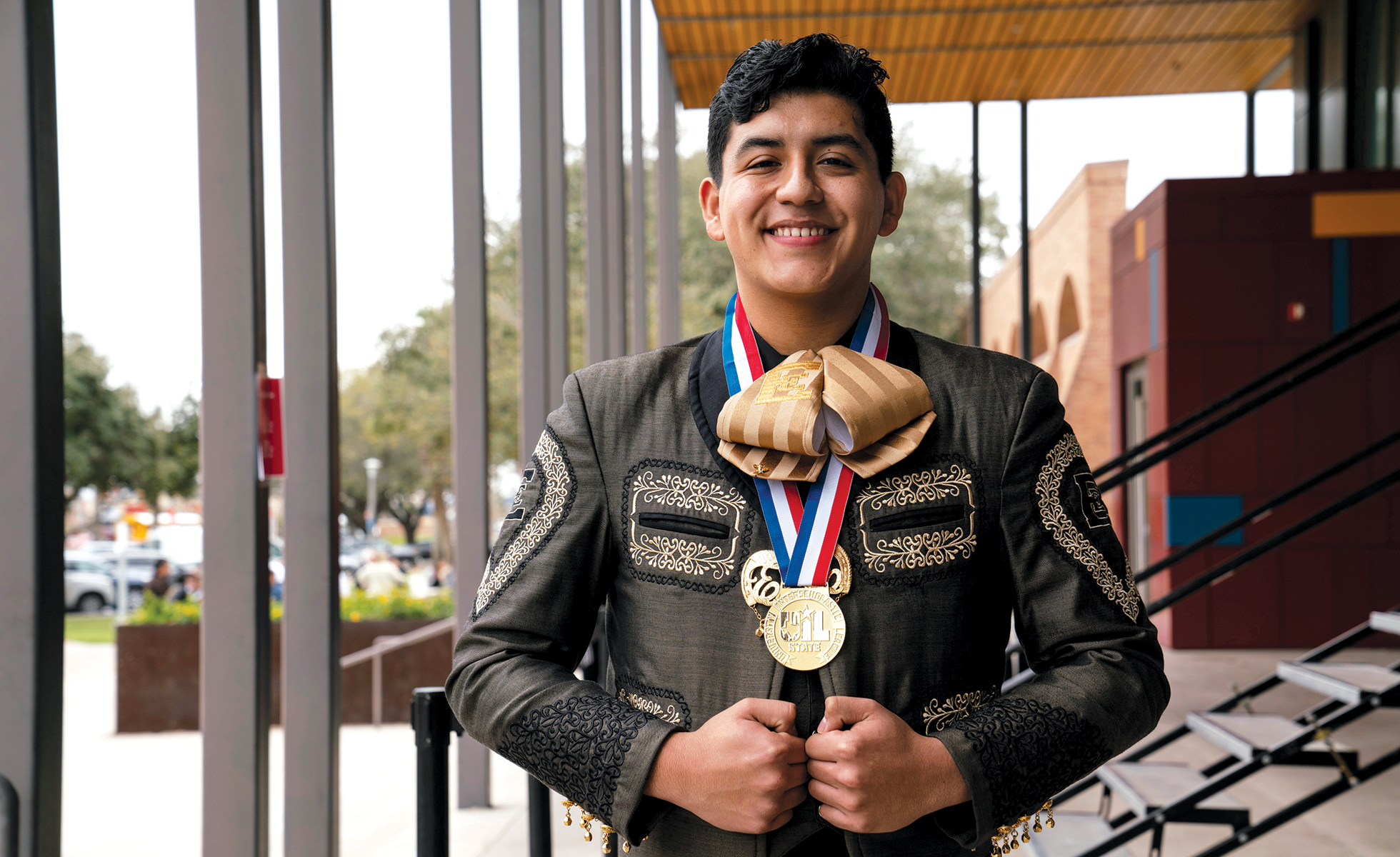
A steady stream of buses pulls up to the UTRGV Performing Arts Center, and students wearing trajes de charro in their school colors disembark, carrying their sombreros in matching bags. Inside, the lobby is crowded with clusters of students in crimson, cream, forest green, royal blue, and black. Parents in mariachi booster club polo shirts keep watch over piles of instruments as the girls touch up their makeup in the restroom. As they lean toward the mirror to slick back an errant curl, the costume jewels dripping from their ears catch the light.
Onstage, the groups assemble in a half-moon: violins at stage right, trumpets in the back, and the armonía—the rhythm section comprising harp, guitarron, vihuela, and guitars—stage left. The larger ensembles have multiple vocalists who take turns setting aside their instruments, singing for a few measures, and passing the microphone to the next person in a carefully choreographed sequence. The more upbeat songs are punctuated with cheers and gritos—high-pitched calls halfway between a laugh and a cry—from musicians and, sometimes, the audience. When the tempo slows for a romantic bolero, the vocalists clutch their chests before sending a note soaring into the air for an improbably long time. I start to understand what Estrada meant when he told me some songs make him feel both “happy and heartbroken.” My initial apprehension about listening to high school performers for two consecutive 11-hour days is replaced by awe at the near-professional quality. What’s more, I realize that, while the UIL has embraced mariachi relatively recently, these student musicians have a broader skill set than many who compete in more-established music contests: They both play an instrument and sing, learn some Spanish, memorize their music, and perform without a conductor.
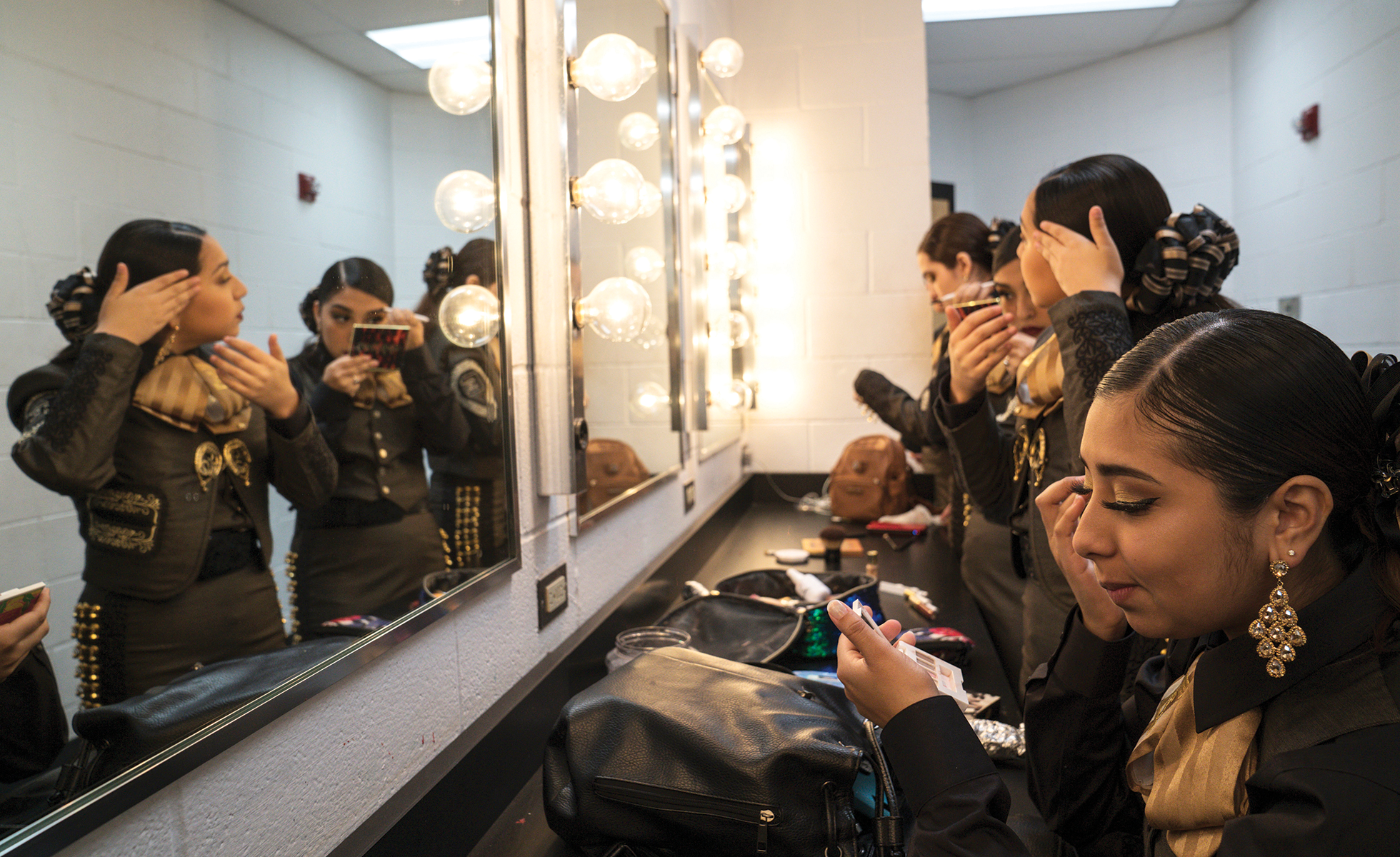
The UIL started offering regional mariachi events in 2008 before piloting the state festival in 2016 and making it permanent last year. In 2016, 55 schools qualified to participate. This year, 82 have made the trip to Edinburg, from as far away as Lubbock, El Paso, and Fort Worth. Bradley Kent, the UIL’s director of music, estimates that about 8 percent of the roughly 1,500 schools the UIL serves have mariachi ensembles. “It’s low in the scheme of things,” he says, “but one reason we started this event was to help grow and develop mariachi programs in the schools.” Rather than pitting schools against one another in a contest that crowns a winner, the festival awards ratings between 1 and 5 to each team, on the theory that this system encourages programs to improve. The judges also recognize a select group of outstanding individual musicians.
When the UIL organizes a new state contest, it’s the secondary-school equivalent of adding an event to the Olympics.
“The mariachi movement in Texas has been going on for a while, but behind the scenes,” says judge John Lopez, a music professor at Texas State University and the director of its mariachi ensembles. “When UIL finally recognized it by starting the mariachi competition, it really took it to a whole other level.”
Two-thirds of the schools at the state festival come from South Texas, where top mariachi programs start in sixth grade and are led by directors who focus on mariachi, not band or orchestra, full time. Garcia and his two co-directors play in the thrice-Grammy-nominated Mariachi los Arrieros del Valle, along with high school directors from nearby towns. “We compete against each other and then we play together on the weekends,” Garcia says with a chuckle. In small Valley towns like Edcouch, Elsa, Roma, Rio Grande City, and Los Fresnos, mariachi receives the community support typically associated with football teams in other parts of the state. Mariachi Nuevo Santander, from Roma, has released two albums and appeared on NBC’s America’s Got Talent. After schools were closed to prevent the spread of COVID-19, a video of the team’s remote practice, assembled from footage of each student playing at home, garnered more than a million views on Facebook.
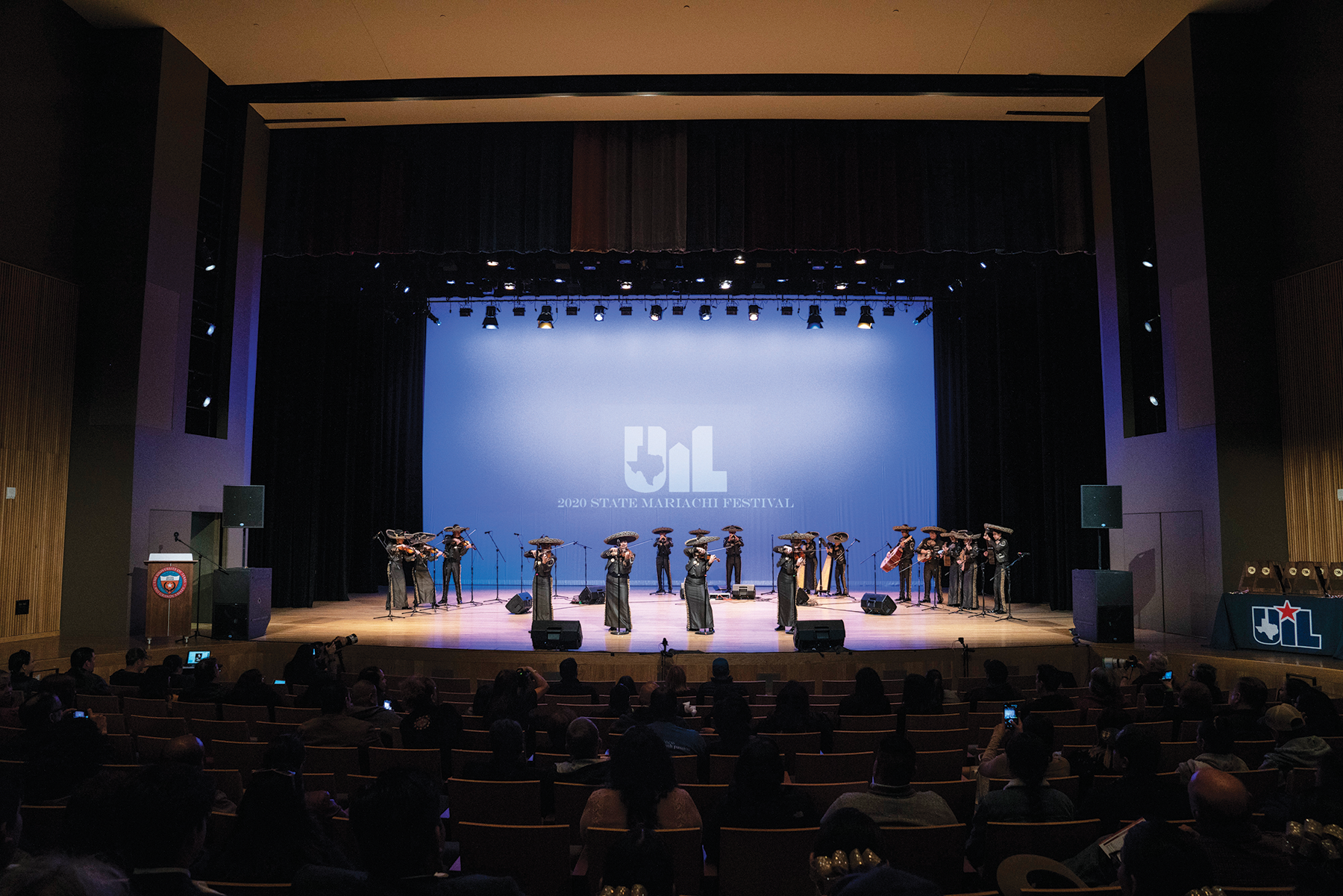
Salazar says the growth of high school mariachi has ripple effects beyond affirming students’ pride in their culture. Because the student groups attract boys and girls in roughly equal numbers, she speculates that the historically male-dominated mariachi genre may soon be reshaped. And, as more students look for colleges where they can keep playing mariachi, universities have a greater incentive to invest in student musical ensembles and academic programs. In a virtuous circle, some of those students will return to the classroom as mariachi directors. A case in point: Daniel Estrada, the trumpet player, plans to study music education at UTRGV next year.
Teaching is only one way to pursue a mariachi career, Salazar says. Baptisms, quinceañeras, weddings, parties, and funerals all create ongoing demand for live mariachi music. The Disney resorts hire mariachis to play full time, and some restaurants have resident mariachi groups. “In the American Southwest, it is possible to make a decent living as a mariachi musician,” she says.
Estrada has glimpsed that prospect. He usually dedicates evenings and weekends to practicing the trumpet and the guitar, or studying YouTube videos that explain musical techniques. At first his father, a diesel mechanic, thought Estrada’s time would be better spent learning how to troubleshoot a transmission. “He was like, ‘Why are you wasting your time on music? You’re never going to get anything from it,’” Estrada remembers. He smiles. “And now I prove him wrong, because I go to gigs and I get paid 50 bucks an hour.”
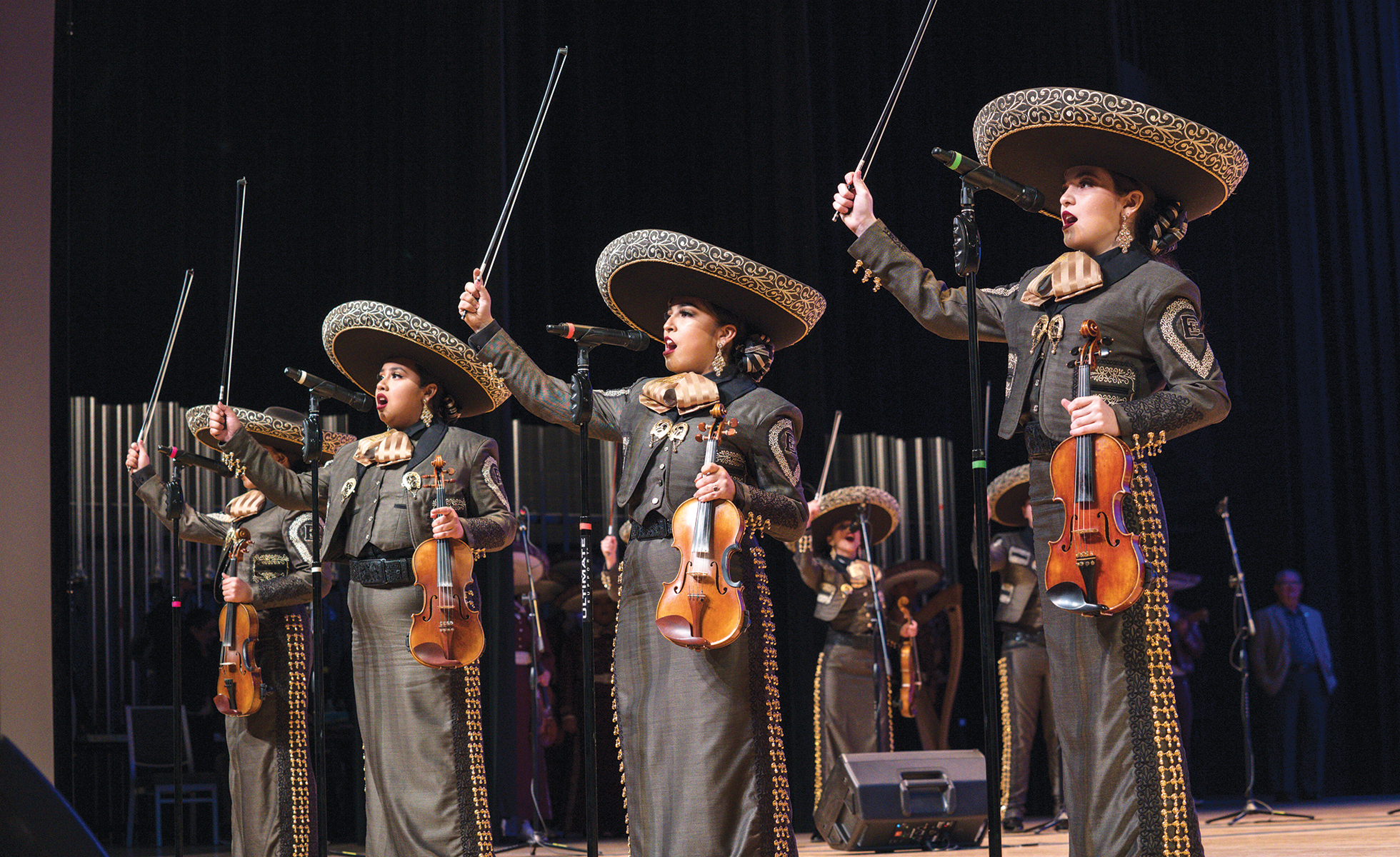
Forty minutes before their performance time, the Edcouch-Elsa musicians are ushered into a warmup room near the UTRGV stage. Garcia leads them in vocal exercises and has the group run through the transitions between songs. Then he calls the group to attention. “We have to focus, communicate, and be consistent,” he reminds them. “Just smile and take deep breaths.” A volunteer knocks on the door, signaling for the group to go backstage. Garcia nods. “Grab your hats, please. It’s time.”
As the group takes the stage, parents and friends erupt in cheers and applause. When the sound dies down, Flores turns, scans the attentive faces, and gives the cue to begin.
The tema starts with an explosion of sound from every instrument. “Juvenil…” Flores sings, her arms outstretched, as the violin players come in with the other lines. As the arrangement shifts into “Toro Coquito,” Flores cries out in a jubilant grito, to the crowd’s delight.
The group’s second song is a popurrí, or medley, of Jorge Negrete songs, which oscillates between upbeat and melancholy. In the final song of the medley, “Ojos Tapatios,” a trio of women weave their voices into harmony. Then Flores sings alone, “Los aires suspiran (the air sighs)…” Angelina Rodriguez turns and gazes upward: “El cielo se apaga (heaven goes dark).” She lets the wistful note hang in the air for a moment before the three finish: “Y en el alma vaga, la queja de amor (and in the soul wanders, the complaint of love).”
As the women lift their violins to end the song, the two harpists bring their instruments forward for the final number, “La Petenera.” They plink out a mysterious tune, then sweep their fingers across the strings in a glissando as the rest of the musicians begin playing with increasing urgency. At last, with Flores and her colleagues’ voices filling the room, the violinists sweep their bows upward, punching them triumphantly in the air. The hometown crowd erupts in applause as the 17 musicians raise their sombreros, bow, and exit the stage.
Each team’s performance is immediately followed by a half-hour clinic with one of the judges. A volunteer leads the students from Edcouch-Elsa into a nearby practice room for their session with Joe Baca of Orlando’s Mariachi Cobre, the resident mariachi band at Disney World’s Epcot Center. Baca first tutors the violin players on the bow techniques that will coax more emotion from their instruments. Then he borrows a guitar and plays a sequence two ways, urging the students to listen for the difference.
“Can you hear it?” he asks, looking around. The students nod. “Those upstrums will be better if you’re relaxed. You don’t have to force a son; you have to feel a son. When you force it, you lose the context.”
After the last group performs, emcee Ruben Adame beckons a representative from each school to the stage, which is soon a rainbow of trajes. Before the expectant crowd, he announces the five schools that have received a Division 1 rating in this morning’s session. When Edcouch-Elsa is called, the team cheers with joy and relief. Adame then recognizes the individual students who have won outstanding performer medals: a vocalist from one school, a trumpet section from another. Then he makes another announcement: “The next outstanding performers are—the entire mariachi group from Edcouch-Elsa High School.” This is the honor they’ve really been aiming for, one that students in most programs can only dream about. The musicians file onto the stage, where medals are draped around their necks before they return to their seats, flushed and beaming.
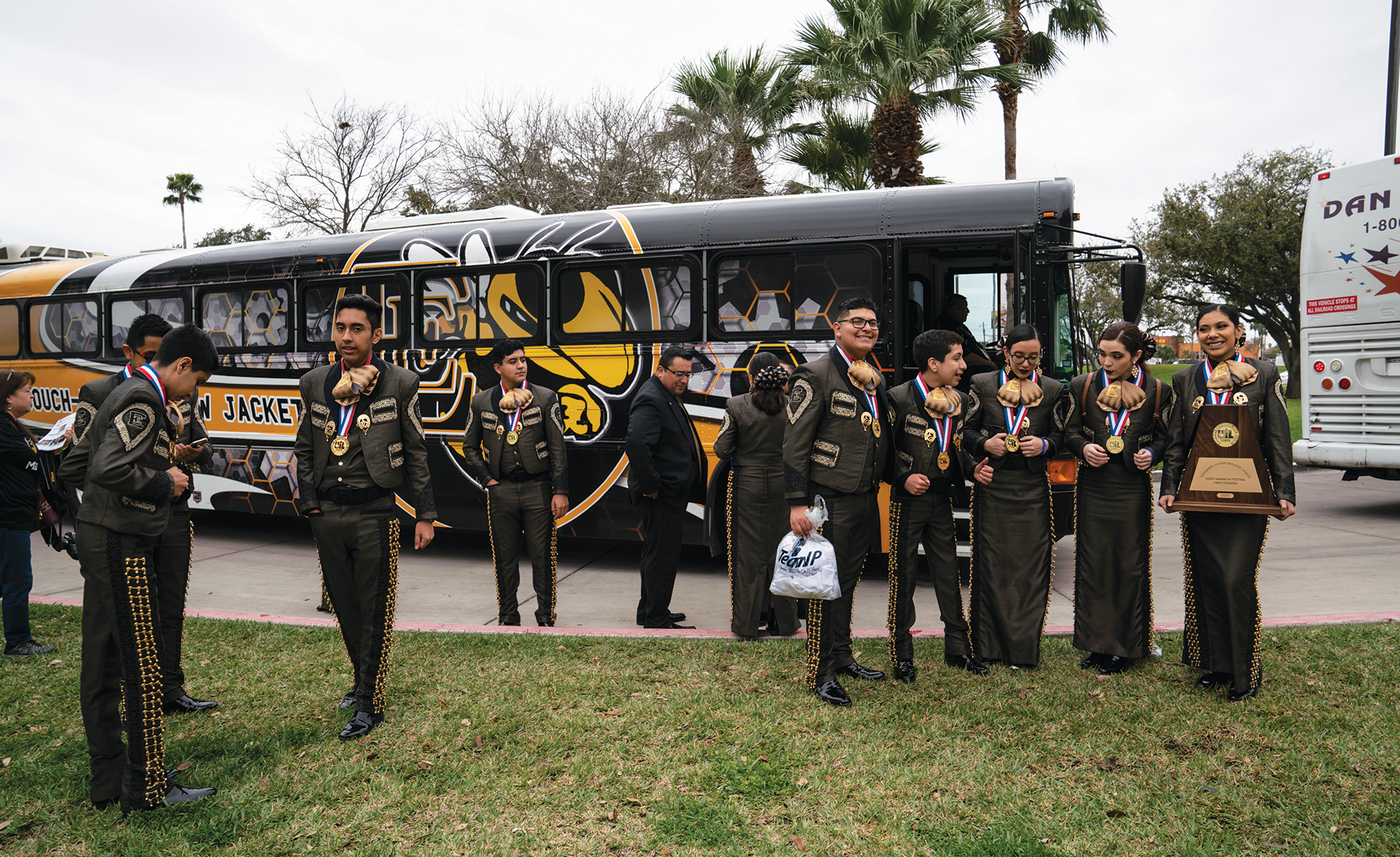
Over the weekend, the judges will award only a dozen first-division ratings. Only one other group will collect outstanding performer medals for every musician.
Outside, the students throw their arms around their friends and family. Estrada is grinning. His father came to watch him perform and gave him a thumbs-up as he received his medal. This evening, Estrada will drive to Brownsville with two other members of Juvenil Azteca for a mariachi gig at a quinceañera. Next year he may perform here again, if he’s successful in his audition for the highly respected UTRGV Mariachi Aztlán. For now, he’s enjoying the moment and the weight of the medal around his neck. As he walks back to the bus, it clanks against the buttons of his jacket in a rhythm that matches his steps.
Read more from the Observer:
Home Wasn’t Safe. Then COVID-19 Made It Seem Like the Only Option: Seeing a “disturbing” decrease in clients and callers amid COVID-19 stay-at-home orders, some domestic violence shelters in rural counties worry this is just the “calm before the storm.”
Norma McCorvey Took the Money of the Anti-Abortion Movement and Lost Herself. ‘AKA Jane Roe’ Is Her Attempt at Atonement: In a stunning deathbed confession, the woman who made Roe v. Wade possible tried to erase years of anti-abortion activism. But the damage has already been done.
Locked Out: Visitation is a critical lifeline for incarcerated people, yet some families say Texas prison officials ban them from seeing loved ones over petty or unproven claims of misconduct.

